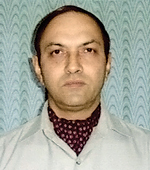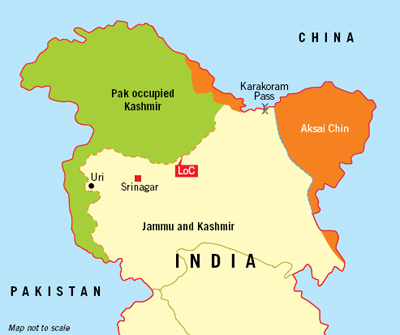INDIAN ARMED FORCES CHIEFS ON
OUR RELENTLESS AND FOCUSED PUBLISHING EFFORTS

SP Guide Publications puts forth a well compiled articulation of issues, pursuits and accomplishments of the Indian Army, over the years

I am confident that SP Guide Publications would continue to inform, inspire and influence.

My compliments to SP Guide Publications for informative and credible reportage on contemporary aerospace issues over the past six decades.
- Prime Minister witnesses 'Bharat Shakti' – a Tri-Services Firing and Manoeuvre Exercise in Pokhran, Rajasthan
- Interim Defence Budget 2024-25 — An Analysis
- Union Defence budget 2024
- Prime Minister Modi Commemorates Indian Navy Day in a Grand Ceremony
- Prime Minister Modi Flies in the LCA Tejas
- New Chapter in India-Italy Defence Ties
- Airpower beyond Boundaries
A brief history of Kashmir dispute

The latest attack on India by fidayeen group in Uri, Jammu and Kashmir, has pushed India-Pakistan relations to the edge again
The partition of the Indian subcontinent along religious lines led to the formation of India and Pakistan and hence the Kashmir dispute dates back to 1947. However, within the subcontinent there existed the problem of over 650 princely states. In theory, these princely states had the option of deciding which country to join, or of remaining independent. In practice, the population of each province who had been fighting for freedom from British rule, were not willing to trust the erstwhile rulers to fill the vacuum after independence.
Because of its location, Kashmir had the choice to join either India or Pakistan. Maharaja Hari Singh, the ruler of Kashmir, was Hindu while most of his subjects were Muslim. Unable to decide which nation Kashmir should join, Hari Singh chose to remain neutral. But his hopes of remaining independent were dashed in October 1947, as Pakistan sent in Muslim tribesmen mixed with regular army personnel, commanded by Pakistani army officers, who were threatening to take over Kashmir by the force of arms and by unleashing violence in the state.

Hari Singh appealed to the Indian Government for military assistance and fled to India. He signed the Instrument of Accession, ceding Kashmir to India on October 26. Indian and Pakistani forces thus fought their first war over Kashmir in 1947-48. India referred the dispute to the United Nations on January 1. In a resolution dated August 13, 1948, the UN asked Pakistan to remove its troops, after which India was also to withdraw the bulk of its forces. Once this happened, a ‘free and fair’ plebiscite was to be held to allow the Kashmiri people to decide their future. India, having taken the issue to the UN, was confident of winning a plebiscite, since the most influential Kashmiri mass leader, Sheikh Abdullah, was firmly on its side. An emergency government was formed on October 30, 1948, with Sheikh Abdullah as the Prime Minister. Pakistan ignored the UN mandate and continued fighting, holding on to the portion of Kashmir under its control.
On January 1, 1949, a ceasefire was agreed, with 65 per cent of the territory under Indian control and the remainder with Pakistan. The ceasefire was intended to be temporary but the line of control (LoC) remains the de facto border between the two countries in Jammu and Kashmir.
In 1957, Kashmir was formally incorporated into the Indian Union. It was granted a special status under Article 370 of India’s Constitution, which ensures, among other things, that non-Kashmiri Indians cannot buy property there. Fighting broke out again in 1965, but a ceasefire was established in September 1965. Indian Prime Minister Lal Bhadur Shastri and Pakistani President Mohammed Ayub Khan signed the Tashkent Agreement on January 1, 1966. They resolved to try to end the dispute, but the death of Shastri and the rise of General Yahya Khan in Pakistan resulted in stalemate.
In 1971, a third war resulted in the emergence and formation of the independent nation of Bangladesh (formerly known as East Pakistan). A war had broken out in East Pakistan in March 1971, and soon India was faced with a million refugees. India declared war on December 3, 1971, after Pakistani Air Force planes struck Indian airfields in the Western sector. Two weeks later, the Indian Army marched into Dhaka and the Pakistanis surrendered.
In 1972 Prime Minister Indira Gandhi and her Pakistani counterpart Zulfikar Ali Bhutto signed the Simla Agreement, which reiterated the promises made in Tashkent. The two sides once again agreed to resolve the issue peacefully, as domestic issues dominated.
Both India and Pakistan had other important domestic problems which kept Kashmir on the back-burner. In 1975 Indira Gandhi declared a state of national emergency, but she was defeated in the 1977 general elections. Zulfikar Ali Bhutto was overthrown and hanged in 1979; Pakistan reverted to military dictatorship under General Zia-ul-Haq.
Influence Wanes
By late 1980s, Kashmiri people’s sympathy with the Indian union started waning due to Mrs Gandhi’s attempts to install puppet governments in state capitals, and manipulating the democratic process in the state legislatures. The status quo was largely maintained until 1989 when Pakistan-based jihadi Tanzims along with local pro-independence militants, trained, equipped and launched from army bases in Pakistan-occupied Kashmir (PoK) by the ISI/ Pakistan Army commenced their terror campaign. They established a reign of terror and drove out almost all the Hindus from the valley before the Indian Army moved in to flush them out. A counter-terror campaign started in 1989 continues even today. Meanwhile at the LoC Indian and Pakistani troops regularly exchanged fire. Attempts by Pakistan in raising this issue in the UN was thwarted by India who insisted that after 1971, the Simla Agreement was the way forward and UN intervention or third-party mediation was not acceptable.
Nuclearisation and Kargil War
Both India and Pakistan became nuclear powers after testing nuclear devices in May 1998, and then in April 1999 test-fired missiles in efforts to perfect delivery systems for their nuclear weapons. Although Pakistan claimed that its missiles were an indigenous effort, in July 1999 Indian customs agents seized components shipped from North Korea which were destined for Pakistan’s missile programme.
A genuine attempt at bringing about peace in the region by the Indian Prime Minister Atal Behari Vajpayee was set in motion in February 1999. He set out to Lahore by bus on February 20, 1999, inaugurating the four times a week Delhi-Lahore-Delhi bus service. The world felt that such a genuine effort at friendly neighbourhood relations would lower the tension along the LoC in Kashmir. But Pakistan once again repudiated the efforts made by Atal Behari Vajpayee. Kargil War began during the mid-1990s and the traitorous attempts by Pakistan at gaining tactical and strategic advantages from occupying dominating heights in Kargil sector proved disastrous as they were evicted from all vital positions by July 4, 1999. In the meanwhile, President Bill Clinton asked Prime Minister Nawaz Sharif to pull back from all areas occupied by it.
The Dispute Continues
We are all aware that Prime Minister Jawaharlal Nehru had formally announced that a plebiscite would be held under the supervision of United Nations once situation became peaceful. However, Pakistan, who had occupied many parts of Kashmir, did not pay any heed to the UN mandate and the Indian Government demanded status quo ante as per the same mandate. Pakistan did not pull back from its positions and thus the plebiscite was never held. After 1971 war and the signing of Simla Agreement by both countries, the issue of plebiscite under the aegis of the UN became irrelevant.
Kargil War, in 1999, saw Pakistan reneging once again and back-stabbing India after Prime Minister Vajpayee’s visit and the signing of the Lahore Declaration on February 21, 1999. The declaration signalled a major breakthrough in overcoming the historically strained bilateral relations between the two nations in the aftermath of the publicly performed nuclear tests carried out by both nations in May 1998. Widely popular in the public circles in Pakistan and hailed by the international community, the relations soon lost the impetus with the outbreak of the Kargil conflict in May 1999.
Despite all efforts from the Indian side to ensure peace and tranquillity through dialogue and negotiations, the so-called democratically elected government of Nawaz Sharif in Pakistan has not been able to deliver. It is obvious that the real power in Pakistan lies with the military and democracy is really a façade as the Kashmir policy is dictated by the military.
Pakistan has adopted the strategy of “bleeding India through a thousand cuts”; waging a proxy war which indeed takes a heavy toll on a defensive India. The latter have not been able to devise an effective counter to the Pakistan’s strategy.
Current Scene
On September 18, 2016, a terrorist group struck a Battalion administrative base in Uri Sector in Jammu and Kashmir. Eighteen soldiers of the Indian Army were martyred and many others injured in the terrorist attack in the early hours of Sunday morning. All four militants were killed within two hours of the commencement of the attack, though combing operations to clear the entire area took longer. However, the casualties suffered by the Army (including injured personnel) were so heavy that it has caught the attention of the entire Indian nation and an atmosphere is being created, especially by the media, for a savage response to teach our perverse and recalcitrant neighbour a lesson. This is the fifth major attack by Pakistan-based terror modules, assisted by their army and the ISI in recent times which includes Gurdaspur (Dina Nagar) on July 27, 2015, Pathankot IAF airbase on January 2, 2016, Pampore attack on June 25, 2016, Poonch attack on September 11 and Uri attack on September 18, 2016.
Considering the present unrest in the valley which has lasted for the past 70 days, aided and abetted by Pakistan, together with the above terror attacks, it becomes evident that a conspiracy has been hatched by Pakistan and their hard core supporters in the valley to highlight and escalate the Kashmir situation for its global impact.
The latest attack on India by fidayeen group in Uri, has pushed India-Pakistan relations to the edge again. As India takes up the issue of Pakistan-sponsored terrorism and the neighbour’s support to terror groups on the global platform, another attack on India, particularly on the armed forces, is clearly testing our patience and could escalate violence to unacceptable levels for both nations.
It would not be out of place to mention that while the country faces two strong adversaries, namely Pakistan in the west and China in the north, the state of our defence forces is pathetic. No modernisation has taken place in the past two decades or so and the situation is dismal. We have not learnt any lessons since the Kargil conflict in 1999. Even the adversaries are aware of our lack of capabilities in many fields and perhaps that is the reason for their aggressive behaviour and designs. Under these circumstances instead of improving our capabilities in order to face the future threats and challenges, we have defence budgets which cater for just maintaining the current force levels. No modernisation is possible with the funds allocated for defence year after year. Our political leadership is neglectful of the ground realities and oblivious of our weaknesses. Mere rhetoric is not going to defeat or deter our adversaries.
If a question were to be asked whether Kashmir is an integral part of India, the answer would be – Yes. But if the question is that do the Kashmiri’s feel that they are a part of India, the answer might not be in the affirmative. There is a lot to be done in this regard and the elected governments must start performing. Poor governance is also a major reason for the current state of affairs. Honest introspection is needed to progress ahead.
The views expressed herein are the personal views of the author.





